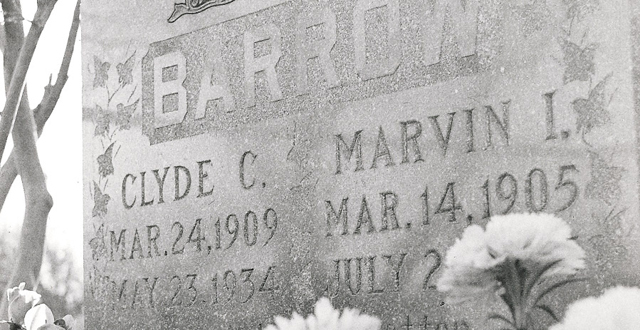OK. Let’s face it. We’ll all pass on at some point. It’s just the way things are. Some of us have made “prior arrangements,” and some of us have not. But any way you slice it, there’ll be a final resting place for us all, unless we’re either swirled out of an urn and scattered to the wind or buried at sea. Yep! “There’s a place for us” … “Somewhere, out there.” Perhaps in Oak Cliff. Many already are here.
If you’ve been hanging around The Cliff for a while, you’re probably aware that the infamous Clyde Chestnut Barrow is among the many notable folks interred in our neighborhood. He’s buried beside his brother Marvin “Buck” Barrow and parents Henry and Cumie Barrow, and his formerly upright marker was stolen so many times from the Western Heights Cemetery on Fort Worth Avenue that when it was recovered the last time, it was recessed into the ground and embedded in solid cement. Now, prying loose the tombstone and carrying it off is no longer a viable option … unless you’re the Incredible Hulk or Superman.
[quote align=”right” color=”#000000″]Nestled just east of the now vacant N. W. Harlee Elementary School on East Eighth lies the signature cemetery in our neck of the woods: The Oak Cliff Cemetery, created in the 1840s. Roaming the grounds, visitors can view several graves with clearly French inscriptions, indicating a person’s inclusion in the short-lived, utopian La Reunion Colony.[/quote]Clyde’s partner in crime, Bonnie Parker, was originally interred in the Fishtrap Cemetery on the northern side of Pinkston High School. In her poem “The Story of Bonnie and Clyde,” Bonnie penned, “Someday they’ll go down together; and they’ll bury them side by side.” But Bonnie’s mother overruled her daughter’s wishes and had Bonnie buried separately, stating that Clyde had had her for the past two years and now the family wanted her to themselves. But, because of flooding issues at the burial ground, Bonnie’s family had her disinterred and moved. She now rests in the family plot at Crown Hill Cemetery.
After purchasing a cemetery on what is now South I-35 E, that originally existed under another name, Laurel Land Memorial Park opened in the early 1940s. Now Oak Cliff’s largest and most recently opened burial ground, it is the final resting place for numerous national figures, some of which may surprise you.
Award-winning singer and guitarist Stevie Ray Vaughan is buried in the “Vaughan Estate,” along with his parents, Jimmie Sr. and Martha Cook Vaughan. Also interred there are V.O. “Virgil” Stamps, co-founder of the Stamps-Baxter School of Music and music arranger of “When the Saints Go Marching In;” LPGA founder Bettye Mims Danoff; singer and songwriter (“My Maria”) B. W. Stephenson; Carter High School grad and Dallas Cowboy running back Ennis Haywood; Artie Glenn, who wrote the song “Crying in the Chapel;”
Richard Lee Newton, who played Judge Richard Cooksey on the TV series “Matlock;” and U.S. Congressman Joe Pool … just to name a few.
One of the most interesting burials in the cemetery is that of singer and musician William “Oliver” Swafford, known to most Baby Boomers as simply “Oliver.”
Oliver’s two big hit songs from the 1960s — “Good Morning Starshine” from the Broadway musical “Hair” and “Jean,” the theme song from the movie “The Prime of Miss Jean Brodie” — became both national and international chart-toppers, each earning the singer a Gold Record. Feeling closed-in with his musical options, Oliver retired from performing in the 1980s and moved to Dallas. According to his obituary, Oliver spent nine happy years in Dallas working for an area homebuilder and in 1991 married a Plano music teacher. He later worked in Louisiana as a business manager for pharmaceutical giant Merck & Co. The former music star died of cancer in 2000 in a Shreveport hospital. The North Carolina native was inducted into the North Carolina Music Hall of Fame in 2010.
However, the most widely recognized person in the cemetery is probably Dallas Police officer J. D. Tippit, murdered on Nov. 22, 1963, by presumed John F. Kennedy assassin Lee Harvey Oswald.
Nestled just east of the now vacant N. W. Harlee Elementary School on East Eighth lies the signature cemetery in our neck of the woods: The Oak Cliff Cemetery, created in the 1840s. Roaming the grounds, visitors can view several graves with clearly French inscriptions, indicating a person’s inclusion in the short-lived, utopian La Reunion Colony. The grounds also reveal gravesites of many early settlers and civil leaders not only of Oak Cliff but of Dallas itself. Among the graves are those of leading Dallas businessman Leslie Stemmons (the namesake of Stemmons Freeway and Stemmons Street in East Kessler) and Henry Boedeker (business owner and developer of what was Oak Cliff’s Boedeker Block). Three Dallas mayors are interred there: David Kerfoot, 1876-77; George Sergeant, 1935-36; and George Sprague, 1938-39. The founder of Skillern’s Drug Stores, W. Arthur Skillern, rests at OCC, along with artist Edward Eisenlohr, U.S. Representative Sterling Strong, 1933-35; a Gettysburg soldier; a Seminole Indian chief; and early Oak Cliff settler William Henry Hord, civic leader and namesake of Hord’s Ridge. A Bavarian immigrant buried there was the first zither player in the United States and played French horn in the first Dallas Symphony Orchestra.
But perhaps the most unusual burial in the cemetery is that of Col. William Rogers Houston, the youngest child of Sam Houston. While on duty as a special officer of the Indian Service of the U.S. Department of the Interior, Col. Houston suffered a heart attack just outside Hugo, Okla., fell from his horse and died. The funeral service was held in Dallas, and Col. Houston now rests … in Oak Cliff!
If all these interesting and notable folks were able to come back and join us for a while, I’m sure we’d learn some extremely interesting facts about our neighborhood and a lot more. But on second thought, we might want to keep Bonnie and Clyde right where they are. Some things are probably better left “as is.”






